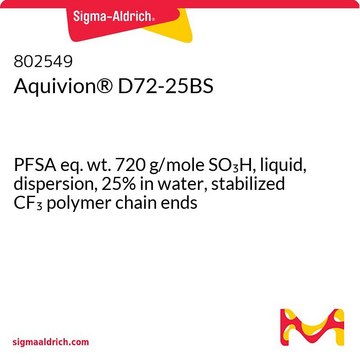推荐产品
等效分子量
1,100
包含
45% water
環保替代產品特色
Design for Energy Efficiency
Learn more about the Principles of Green Chemistry.
sustainability
Greener Alternative Product
濃度
5 wt. % in mixture of lower aliphatic alcohols and water
折射率
n20/D 1.368
bp
84 °C
密度
0.921 g/mL at 25 °C
環保替代類別
InChI
1S/C7HF13O5S.C2F4/c8-1(9)2(10)24-5(15,16)3(11,4(12,13)14)25-6(17,18)7(19,20)26(21,22)23;3-1(4)2(5)6/h(H,21,22,23);
InChI 密鑰
FOYUGSIADQEOEK-UHFFFAOYSA-N
正在寻找类似产品? 访问 产品对比指南
一般說明
應用
包裝
外觀
法律資訊
訊號詞
Danger
危險分類
Eye Dam. 1 - Flam. Liq. 2 - STOT SE 2 - STOT SE 3
標靶器官
Eyes,Central nervous system, Respiratory system
儲存類別代碼
3 - Flammable liquids
水污染物質分類(WGK)
WGK 3
閃點(°F)
68.0 °F - closed cup
閃點(°C)
20 °C - closed cup
商品
Fuel cells have the potential to reduce the nation’s energy use through increased energy conversion efficiency and dependence on imported petroleum by the use of hydrogen from renewable resources.
质子交换膜(PEM)燃料电池由两个电极和一种导电电解质组成,可在相对较低的温度下运行。
Proton exchange membrane (PEM) fuel cells operate at relatively low temperatures and are composed of two electrodes and a conductive elecrolyte.
Advances in the electrochemical conversion of water to and from hydrogen and oxygen have principally been achieved through the development of new materials and by understanding the mechanisms of the degradation of proton exchange membrane fuel cells (PEMFC) during operation.
相关内容
Batteries, fuel cells and supercapacitors are energy conversion and storage devices based on electrochemical energy production at the electrode/electrolyte interface and electron/ion transport separation.
Batteries, fuel cells, and supercapacitors rely on electrochemical energy production. Understand their operation and electron/ion transport separation.
我们的科学家团队拥有各种研究领域经验,包括生命科学、材料科学、化学合成、色谱、分析及许多其他领域.
联系技术服务部门











